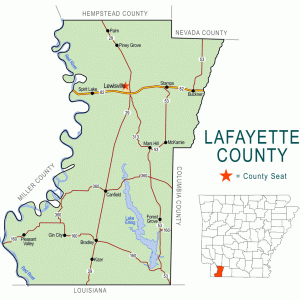calsfoundation@cals.org
Buckner (Lafayette County)
| Latitude and Longitude: | 33°21’30″N 093°26’10″W |
| Elevation: | 292 feet |
| Area: | 1.18 square miles (2020 Census) |
| Population: | 165 (2020 Census) |
| Incorporation Date: | May 11, 1885 |
Historical Population as per the U.S. Census:
|
1810 |
1820 |
1830 |
1840 |
1850 |
1860 |
1870 |
1880 |
1890 |
1900 |
|
– |
– |
– |
– |
– |
– |
– |
– |
312 |
400 |
|
1910 |
1920 |
1930 |
1940 |
1950 |
1960 |
1970 |
1980 |
1990 |
2000 |
|
240 |
360 |
264 |
450 |
335 |
289 |
392 |
436 |
325 |
396 |
|
2010 |
2020 |
|
|
|
|
|
|
|
|
|
275 |
165 |
|
|
|
|
|
|
|
|
Buckner is a town in northern Lafayette County, a few miles east of Stamps (Lafayette County) on U.S. Highway 82. Established by the Cotton Belt Railroad, Buckner was a lumber center early in its history, but the economy of the town in the twenty-first century is shaped more by its proximity to oil and gas fields and to poultry farms.
What would become northern Lafayette County was heavily forested when Arkansas became a state in 1836. Caddo, who lived along the Red River valley, moved through the area regularly. Gradually, white settlers began to claim and clear land in the region. Because the area remained sparsely populated, the Civil War had little effect upon the area.
John Colvin was farming in the region in 1882 when the St. Louis Southwestern Railroad, commonly called the Cotton Belt, began acquiring land for a railroad line through southern Arkansas. Colvin sold land to the railroad in 1883; at the time, this land was in Columbia County. The railroad established a depot and platted a town north of the tracks. At first, the town was known as Barker, but land agent C. F. Stephens changed the name to Buckner to honor Buckner Fisher, the son of a friend who lived in St. Louis, Missouri. A post office was established at Buckner in 1883, and the town was incorporated in 1885.
By 1890, the town had grown to 500 people, most of whom were white. Four stores had opened in 1883, and several sawmills were built during the decade, including a planing mill. Buckner also had a cotton gin and two grist mills. The Clear Creek Lumber Company established works in Buckner in 1889. A newspaper, first called the Arkansas Siftings and later the Buckner News, began publication in 1887. In the words of Arkansas newspaperman Fred Allsopp, the newspaper was “not a permanent success.” A physician, John H. Percy, began practice in Buckner in 1888. The county line between Columbia County and Lafayette County was adjusted in 1890, moving Buckner into Lafayette County.
In its early years, Buckner had three churches, two serving white congregations—one Baptist and another Methodist Episcopal South—and St. John Baptist Church, an African-American church that also operated a school for Black children. White children attended classes at the Price Academy in Buckner. The Price Academy later became a public high school with 250 to 300 students. Two banks opened in Buckner around 1920. Arkansas Highway 2, which became U.S. Highway 82, was built around 1926 with a route parallel to the railroad tracks.
By 1930, the lumber business had fallen into decline, although Buckner weathered the Depression as well as most small towns. It continued to support a bank, a dry goods store, a barber shop, a hardware store, three service stations, several grocery stores, a city park, the post office, and the railroad depot. A Greyhound bus traveled along Highway 82, stopping at the Riggins Grocery store in downtown Buckner. Before elections, candidates would draw large crowds to the city park for their speeches and rallies.
In the 1970s and 1980s, Highway 82 was improved, with routes bypassing most of the cities and towns on its path, including Buckner. This led to a decline of the town, with most of the stores closing or relocating. In 1986, Lake Columbia was created in Columbia County a few miles southeast of Buckner on Beech Creek. The lake and surrounding property provide fishing and water recreation opportunities as well as camping.
By 1998, Buckner had one grocery store, the post office, and the Methodist and Baptist churches. The school was consolidated with the Stamps School District. Poultry farming and some mining for oil and natural gas provide jobs to area residents. As the population of Buckner declined, its make-up became increasingly African American. In the 2000 census, the population was fifty-three percent white, but by 2010, there were 142 Blacks and 124 whites.
For additional information:
The Goodspeed Biographical and Historical Memoirs of Southern Arkansas. Chicago: Goodspeed Publishing Company, 1890.
Knight, Wilda, ed. Lafayette County, Arkansas: Pieces of Its Past and Its People. Lewisburg, AR: Lafayette County Historical Society, 2002.
Steven Teske
Butler Center for Arkansas Studies





Comments
No comments on this entry yet.